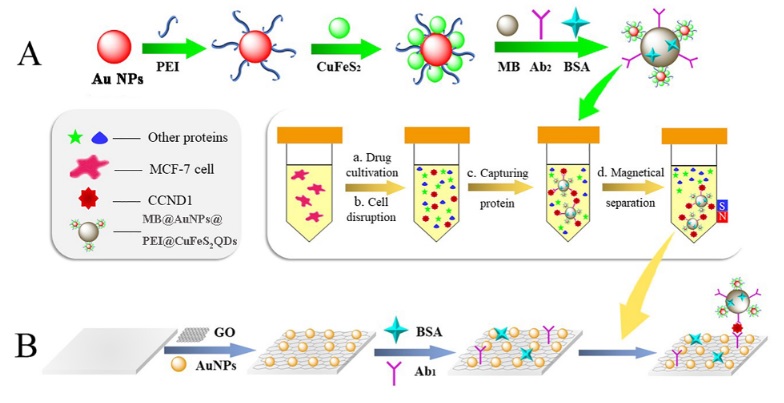赵文波教授课题组在JOURNAL OF ELECTROANALYTICAL CHEMISTRY发表研究论文
Electrochemiluminescence immunosensor based on signal probe CuFeS2 quantum Dots for ultrasensitive detection of cyclin D1
Yang, AZ (Yang, Anzi)[ 1 ] ; Huangfu, XX (Huangfu, Xiaoxia)[ 1 ] ; Liu, LX (Liu, Lixiao)[ 1 ] ; Luo, W (Luo, Wen)[ 1 ] ; Zhao, WB (Zhao, Wenbo)[ 1 ]*(赵文波) ; Yin, J (Yin, Jun)[ 2,3,4 ]*
[ 1 ] Nanjing Normal Univ, Ctr Biomed Funct Mat, Sch Chem & Mat Sci, Jiangsu Key Lab Biofunct Mat,Natl & Local Joint E, Nanjing 210023, Peoples R China
[ 2 ] Minist Educ, Key Lab Pesticide & Chem Biol, Wuhan 430079, Peoples R China
[ 3 ] Int Joint Res Ctr Intelligent Biosensing Technol, Wuhan 430079, Peoples R China
[ 4 ] Cent China Normal Univ, Coll Chem, Wuhan 430079, Peoples R China
JOURNAL OF ELECTROANALYTICAL CHEMISTRY,202008,871,114269
Biomedical detection needs to develop more detection methods and reagents. CuFeS2, an I-III-IV ternary semiconductor material, has attracted great interest of researchers because of its optical, electrical, low toxicity and controllable chemical synthesis. Here, we synthesized CuFeS2 quantumdots (QDs) with hot-injectionmethod and their ECL behaviors were investigated for the first time, involving the co-reactant anode/cathode ECL emission and the related ECL mechanism. Moreover, a novel ECL immunosensor based on CuFeS2 QDs for the ultrasensitive detection of Cyclin D1 (CCND1) was designed and prepared. CuFeS2 QDs with uniform size and excellent optical properties were used as ECL emitters and Carboxyl Fe3O4 magnetic beads (MB) were utilized for magnetic separation of CCND1 from MCF-7 cells treated by sophora frevescens. In addition, reduced graphene oxide (rGO) andAuNPs by electrodeposition not only provided plentiful active sites for the immobilization of anti-CCND1 (primary antibody, Ab(1)), but also enhanced the conductivity of the electrode. Results indicated that under the optimal condition, the ECL signal was proportional to the logarithmic of CCND1 concentration in the linear range from 40 fg/mL to 0.8 mu g/mL with a detection limit of 15.8 fg/mL. Further, the good reproducibility, stability and selectivity of the as-prepared ECL immunosensor were also proved. Significantly, the anticancer effect of sophora frevescens on MCF-7 cells was investigated through quantitative analysis of overexpression of CCND1, which was related to proliferation of cancer cells. This research indicated the ECL immunosensor we suggested could offer great potential for the follow-up research in clinical diagnosis and anticancer drug screening.

文章链接:
https://www.sciencedirect.com/science/article/pii/S1572665720304975?via%3Dihub
版权与免责声明:本网页的内容由收集互联网上公开发布的信息整理获得。目的在于传递信息及分享,并不意味着赞同其观点或证实其真实性,也不构成其他建议。仅提供交流平台,不为其版权负责。如涉及侵权,请联系我们及时修改或删除。邮箱:sales@allpeptide.com